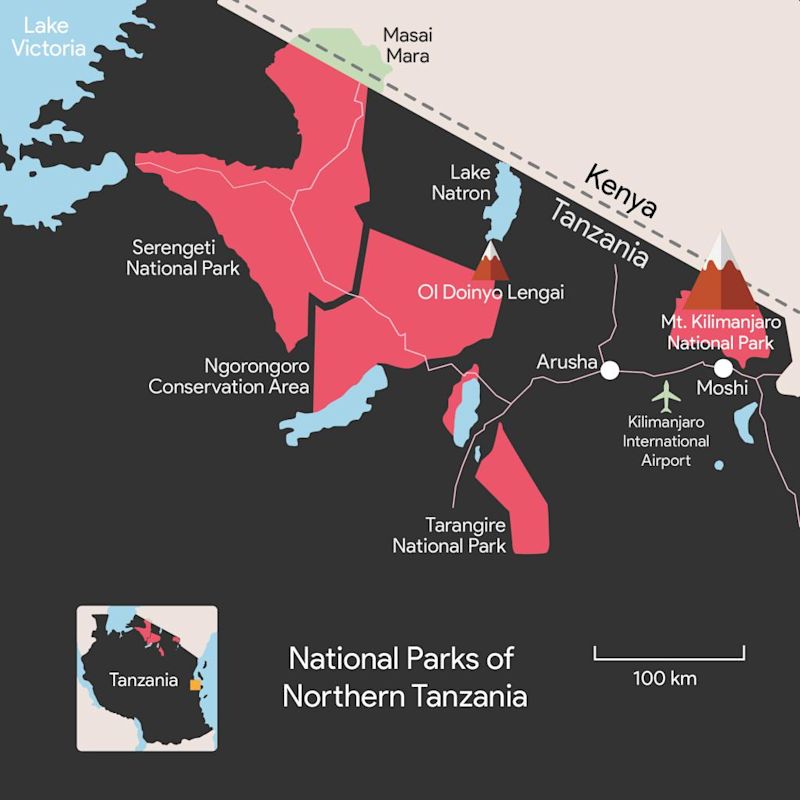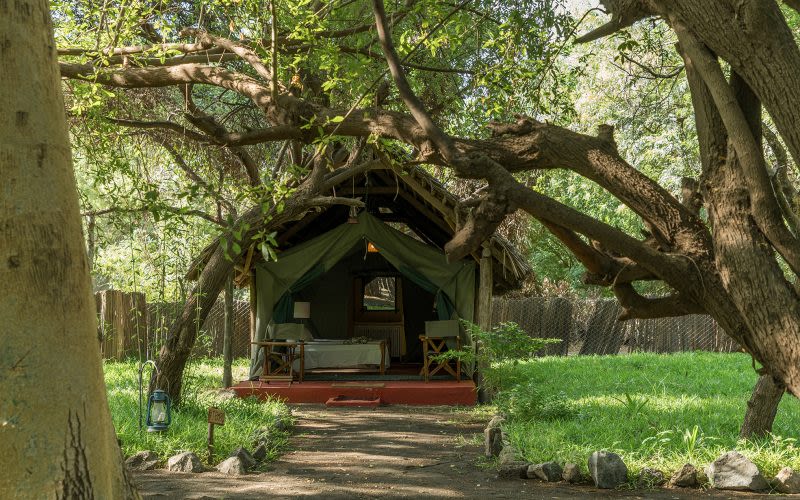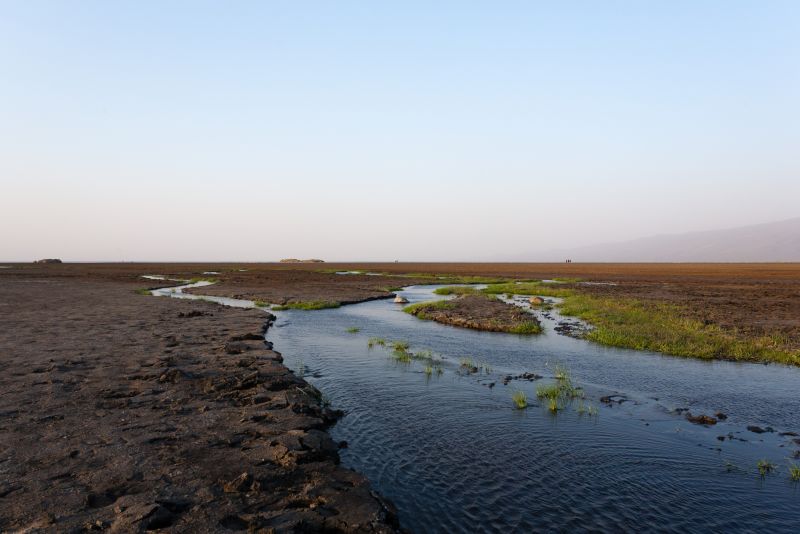Right next door to Lake Natron is Ngare Sero gorge. This 600 metre-deep crack in the Great Rift Valley has a pretty waterfall that you can hike to by walking up the river. The waterfall is part of a beautiful, small oasis where hikers love to swim.
Standing under the powerful waterfall and swimming in its pool is the perfect reward for hiking in the heat to get there!
A fabulous lil' hike
The first hundred metres of the Ngare Sero waterfall hike doesn't look like much. But once you enter the gorge proper, you quickly realise you're in for a real treat!
The hike takes you along the bottom of the gorge. Mostly you walk over the rocks alongside the Saitoti River, but you also often crisscross the river. And sometimes you simply walk right on up the riverbed!
Look for desert roses
Ask your guide questions should you like to know the names of the plants you see during the hike.
And look for desert roses early on (before the gorge's walls grow too steep).
This desert rose bush – a big one – is growing not far from the gorge
Desert roses flower in the dry season (May to October), and their deep pink blooms are just beautiful. The plant's bulbs are poisonous, however. Interestingly, the Maasai (back when they were hunters) used the bulbs' juice to coat their arrows.
The waterfall
The highlight of the hike is most certainly reaching the Ngare Sero waterfall and spending time there.
Nowhere else in this savannah region can you find such deep greenness! The palm trees seem wonderfully out of place. This spot really is a sanctuary.
Depending on when you visit, you may well have the whole pool – indeed, the entire gorge – all to yourself! This is a very remote region, and not all who visit Lake Natron make the effort to do the hike.
Swimming in the pool
You're allowed to swim in the pool
Standing beneath the waterfall, you discover that it's surprisingly powerful. VERY powerful, in fact. It's like receiving a pummelling from the world's strongest massage gun. You can't stand under it for too long, as a result. But it's an incredible experience!
The Ngare Sero waterfall doesn't actually form part of the canyon's Saitoti River. Rather, it drops down into Saitoti from the side.
You can actually walk a few metres upstream from the waterfall (to the left in the picture above). There you'll discover another smaller, but much wider and more powerful, waterfall. This waterfall prevents you from hiking up the river any further.
How long is the hike?
The hike from the trailhead to the waterfall takes about 25 to 45 minutes each way depending on your pace.
How hard is the hike?
The hike isn't hard at all. You only ascend about 300 m.
The main challenge is that your feet are wet most of the time, as you must walk up the riverbed at various points, and it can be slippery in places. Occasionally, the volcanic ash beneath your feet can also give way, depositing you a foot or so lower than expected until you land on firm rock.
How to get there
The Ngare Sero gorge is a stone's throw from the southern tip of Lake Natron. You can see the lake just next to the Kenyan border in the map below.
Map showing Lake Natron and other highlights of northern Tanzania
If you'd like to have a longer hike than that offered by the gorge alone, you could always opt to hike from your campsite to the start of the gorge and then back again. You should see some game like zebra and giraffe on such a hike. And this is a fantastic area for birding too. Look for egrets, bee-eaters, lapwings, vultures and eagles, among many others.
Coming from Lake Manyara
Most people drive to Lake Natron from Lake Manyara in the south. It's a long and bumpy journey that takes anywhere from three to four hours to navigate safely. And you have to travel in a sturdy four-wheel-drive to cope with certain sections, especially when nearing Lake Natron.
There are plans afoot to build a tarred road that would make accessing the Lake Natron region much easier, but for now it remains a hard-to-reach place.
The drive is a fascinating one, however. You pass many rural Maasai settlements and even a few small farms. And you will pass many, many Maasai walking long distances on foot. The Maasai are known for their endurance; they regularly walk long, long distances that would make most foreigners feel faint at the thought.
For the entirety of the drive you travel parallel to the Great Rift Valley escarpment, which runs for 10,000 km (6,200 mi) from north to south! 🤯
There's also beautiful vegetation to appreciate, including countless acacias, euphorbia forests, milkweeds, sisals, and even ficuses by the streams. All of the rocks in the region are black because this is volcanic land.
The road to Lake Natron with Mt Ol Doinyo Lengai presiding
As you get close to Lake Natron, you pass right by Mt Ol Doinyo Lengai (see above), which is the 'Mountain of the Gods'. It's an active volcano that you can hike on an overnight expedition. Keep your eyes open for antelopes and other wildlife when you reach the slopes of Ol Doinyo.
Coming from the Serengeti
You can also head to Lake Natron from the northern section of Serengeti National Park in the west. But this is only the case in the dry season – the road is impassable during much of the rainy season.
Flying in
If you have very deep pockets, you could look into flying to the lake's little airstrip. But the airstrip is mostly just the preserve of the region's flying doctor. Pretty much everyone – and everything – heading to the region comes in by road.
Where to stay
If you're keen to hike to Ngare Sero waterfall, then you need to overnight in the Lake Natron region. And note that because of the lake's remoteness, you'll want to spend at least two nights there. But trust us, once you get there, you'll be super glad that you're not rushing off the next day!
This is the sort of area you want to relax and sink into (pun intended, because you sink through the volcanic ash when you step on it).
There's a handful of really lovely accommodation options in the area ranging from budget to luxury.
The luxury glamping options of Africa Safari Lake Natron and Lake Natron Camp are close to the lake, and so require a drive of about 30 minutes to reach the start of the Ngare Sero waterfall hike.
Most of the other accommodation options like Maasai Giraffe Eco Lodge, Lake Natron Halisi Camp and Natron River Camp are closer to the gorge and so require a shorter drive (around 15 minutes). Or you can even just walk there.
A permanent tent at Natron River Camp
Note that some of the accommodations in Lake Natron are eco-friendly establishments. It's nice to know that you can stay somewhere that'll help you to minimise your eco footprint if you wish.
The meaning of Ngare Sero
Ngare sero means 'spreading waters'. As you can see below, when the Ngare Sero river flows out of the gorge, it enters a plain where it meanders in ribbons until it finally flows into Lake Natron.
The delta of the Ngare Sero River
If you stay at Lake Natron Camp (our favourite), you can actually take a dip in the Saitoti River delta. Bliss. And little black fishies will come to nibble at your feet if you sit still for long enough!












